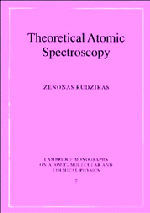Book contents
- Frontmatter
- Contents
- Preface
- Foreword to the Paperback Edition
- Introduction
- Part 1 Energy Spectrum of Many-electron Atom. Radiative and Autoionizing Transitions (Initial Formulas)
- Part 2 Foundations of the Angular Momentum Theory. Graphical Methods
- Part 3 Description of Complex Electronic Configurations
- Part 4 Second-quantization in the Theory of an Atom. Quasispin and Isospin
- Part 5 Matrix Elements of the Energy Operator
- 19 The energy of a shell of equivalent electrons
- 20 Interaction energy of two shells in LS coupling
- 21 Semi-empirical methods of calculation of the energy spectra
- 22 Hyperfine structure of the energy spectra, isotopic and Lamb shift
- 23 Quasispin and isospin for relativistic matrix elements
- Part 6 Electric and Magnetic Multipole Transitions
- Part 7 Calculation of Energy Spectra and Electronic Transitions in the Case of Complex Configurations
- Epilogue
- References
- Index
21 - Semi-empirical methods of calculation of the energy spectra
Published online by Cambridge University Press: 21 September 2009
- Frontmatter
- Contents
- Preface
- Foreword to the Paperback Edition
- Introduction
- Part 1 Energy Spectrum of Many-electron Atom. Radiative and Autoionizing Transitions (Initial Formulas)
- Part 2 Foundations of the Angular Momentum Theory. Graphical Methods
- Part 3 Description of Complex Electronic Configurations
- Part 4 Second-quantization in the Theory of an Atom. Quasispin and Isospin
- Part 5 Matrix Elements of the Energy Operator
- 19 The energy of a shell of equivalent electrons
- 20 Interaction energy of two shells in LS coupling
- 21 Semi-empirical methods of calculation of the energy spectra
- 22 Hyperfine structure of the energy spectra, isotopic and Lamb shift
- 23 Quasispin and isospin for relativistic matrix elements
- Part 6 Electric and Magnetic Multipole Transitions
- Part 7 Calculation of Energy Spectra and Electronic Transitions in the Case of Complex Configurations
- Epilogue
- References
- Index
Summary
Least squares fitting
The methods of theoretical study of the energy spectra of atoms and ions, described in the previous chapters, do not always ensure the required accuracy. Therefore, in a number of cases, when we are not interested in the accuracy of the theory and when part of the data is available (e.g. experimental measurements of the energy levels, which are usually known to high precision), then we can utilize the latter for the so-called semi-empirical evaluation of wave functions and other spectroscopic characteristics. The most widespread is the semi-empirical method of least squares fitting. As a rule, it is used together with diagonalization of the total energy matrix, built in a certain coupling scheme, to find the whole energy spectrum and corresponding eigenfunctions of an atom or ion. The eigenfunctions are used further on to calculate the oscillator strengths, transition probabilities and other spectral characteristics. Let us sketch its main ideas.
As we have seen while considering the matrix elements of various operators, any expression obtained consists of radial integrals and coefficients. These coefficients can be calculated using the techniques of irreducible tensorial sets and CFP, whereas the values of radial integrals are found starting with analytical or numerical radial wave functions. Uncertainties of these quantities calculated in a given approximation (it is well known, for example, that the Hartree-Fock values of radial integrals of electrostatic interactions in some cases exceed the exact ones by 1.5 times) are the main reason for discrepancies between calculations and experimental measurements of spectral characteristics. In a semi-empirical approach we consider these integrals as unknown parameters which can be determined from experimental data by extrapolation or interpolation.
- Type
- Chapter
- Information
- Theoretical Atomic Spectroscopy , pp. 248 - 260Publisher: Cambridge University PressPrint publication year: 1997



